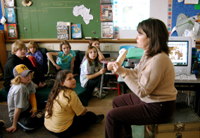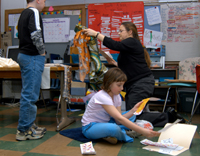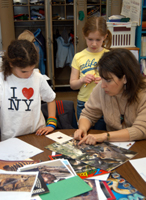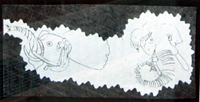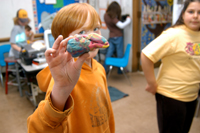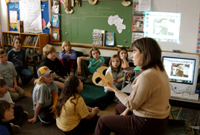During our study of world hunger, children recognized Africa as a world "hot spot" for this problem. Cindy and I made a decision to study what these cultures bring as contributors to a richer world as well as the problems.
Documentation Examples > Documentation Exhibition
Beginning the Journey: Learning through teacher and student documentation
School: Wickliffe Progressive Community School, Columbus, OH
3. Sketching, Modeling, Mask Making
With this goal in mind, Cindy is working with 3rd graders exploring African fabrics and printing.
The fourth graders are in my room exploring mask making.
I have broken the mask making into a 3- stage process. We began with sketching from photographs looking at details through small windows that allowed us to isolate and focus on various features. We then sketched the entire head (the part that will become the mask) from more than one perspective. After the sketching we are moving into 3 dimensions making modeling-clay animal heads using the sketches and photos as references. The final step is to use a variety of materials to make a permanent mask.
We are a couple weeks into the mask project and I think I am learning more than the children. Most are done with their sketches, some kids are finished with their 3-D clay models and a few have begun their permanent masks. Before beginning the work today, children responded in writing to one of 4 questions posed to them. (Thanks to Cindy for posing these or similar questions first.)
THE PROCESS STEP 1: SKETCHING
While sketching from photographs, children were taught how they could use windows cut into cards to view elements of a subject rather than the whole animal.
Students drew various parts of the animals before attending to the whole from different points of view. By eliminating the full image, their attention was redirected to specific details. In most cases students' work became more detailed and accurate. Even in the case of a student who joined us mid-process and who missed discussions about how this could work, the focus provided by using these windows made a significant difference in attention to detail through the remainder of the project.
STEP 2: MODELS
In asking children to precede the making of masks with a clay model I was inspired by animators who frequently develop 3-dimensional models to guide them when drawing characters from various perspectives and in different positions.
For me, effectively teaching an artistic process means modeling the work I am asking children to do. (Not being a trained or skilled art teacher I have not found any other way.) During the modeling process I think out loud, making revisions and discussing mistakes. I invite students to think with me. Children's observations and suggestions are incorporated into my work.

